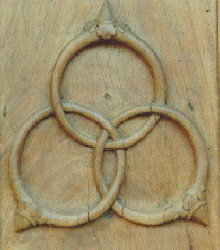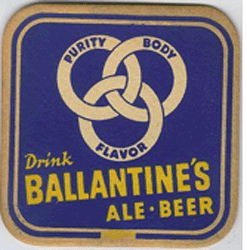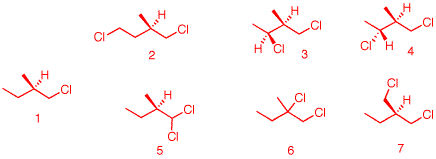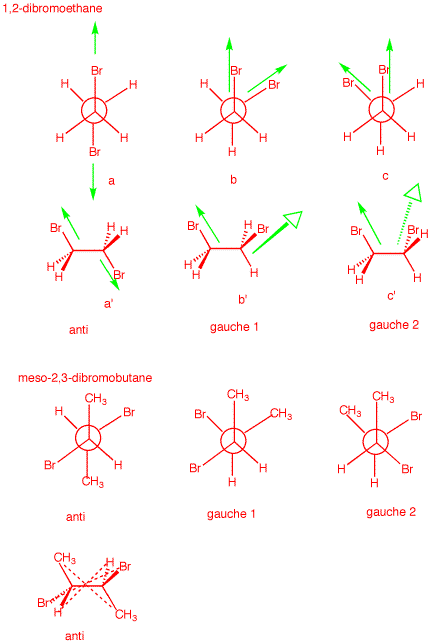Chem 220 - Organic
Chemistry
Solution Set
Stereochemistry
Chapter 5
Due: Monday, October
4, 2010

|
The
Borremean Rings
Versions of this symbol date to the time
of the Vikings.
In the 15th century, it was the symbol of a tripartite
alliance of the Milanese families Visconti, Sforza and
Borromeo via intermarriage. Break any (wedding?) ring and
the others separate, hence the alliance is broken. The rings
form a chiral
object (left) that is not
superimposable on its mirror
image. A set of Borremean rings
has been used as the logo for a certain refreshment that
extols purity, body, and flavor. Is the sense of chirality
of the two sets of Borremean rings the same or different?
For some other discourses on chirality, see:
Potpourri
The Figure 8
Knot
Gentlemen's
Neckties
Molecular
Knots
Snails and
Crabs
Snails, Snakes and Darwin (html)
1
2
(pdf) 1
2
|

|
Read the stereoisomers
module in the StudyAids and do the
exercises. There is no need to record answers on your
homework.
Don't forget the Chirality
of Shells (Powerpoint). Do
left-handed whelks have a better survival rate than their mirror
image brethren? Click here.
|
1. When
(R)-1-chloro-2-methylbutane undergoes free radical
chlorination, five dichloro constitutional isomers are
formed. What are these structures? Draw them. Be explicit as
to diastereomers, enantiomers, racemates, etc.
The four
constitutional isomers (same atom connectivity) are: 2, (3,
4), 5, 6 and 7. Still optically active: 6 (R), 3 (2S, 3S), 4
(2S, 3R) and 5 (R). Notice in 3 and 4, which are
diastereomers, the R, S-configuration has changed although
the asymmetric center has not been altered. This is a change
in group priority. #6 is racemic because abstraction of the
tertiary hydrogen in the first propagation step creates a
planar radical. In the second propagation step, chlorination
occurs with equal facility on either face of the planar
radical. #7 is achiral; two identical groups,
-CH2Cl, in the molecule.

|
|
2. A 4:1 mixture of enantiomers has [α]D
= +120o. What is the rotation of the levorotatory
enantiomer? The dextrorotatory enantiomer? Show work.
Because the net
rotation is positive, the major enantiomer must be
dextrorotatory; the minor one, levorotatory. A 4:1 mixture
is 80% dextro-, 20% levo. Thus, +120 = 0.80x(+rot.) +
0.20x(-rot.); +120 = 0.60x(+rot.); +rot. = 120/0.60 =
+200o for the dextrorotatory enantiomer;
-120o for the levorotatory
enantiomer.
|
|
3. a) 1,2-Dibromoethane is optically
inactive yet it has a dipole moment. Explain and illustrate.
[Hint: Draw the staggered conformations and assess
optical activity and dipole moment for each.]
Optical activity
is an algebraically additive property; dipole moments are
cumulative in nature. The three staggered conformations of
1,2-dibromobutane are shown on the right in both Newman
projections and sawhorse views. The anti conformation has no
net dipole. The bond dipoles cancel. [Only the
green
C-Br bond dipoles are shown.] The two gauche
conformations have net dipoles. The vector sum of the bond
dipoles gives the molecular dipole. As to optical activity,
the anti conformation is achiral [center of
symmetry]. The gauche conformations are chiral and form
a racemate. No net optical activity.
b) meso-1,2-Dibromobutane exists in three staggered
conformations, none of which has a plane
of symmetry. Yet the compound is
optically-inactive. Indeed, the only conformation that has a
plane of symmetry is quite unstable. Explain and
illustrate.
Gauche 1 and 2
form a racemic pair (external comparison). The anti
conformation has a center of symmetry at the center of the
C2-C3 bond (internal comparison).
|

|
4. Which of the following compounds are, in
principle, capable of resolution? Explain and illustrate. [For
3-D Jmol views of these structures click here.: 5a,
5b,
5c,
5d,
5e,
5f.]

5a) This biphenyl is not planar
owing to the four large groups at the ortho positions that inhibit
planarity. The two rings are orthogonal to one another thereby
producing two non-superimposable mirror images.
b) This compound can be
resolved. Imagine that the CO2H group is above the plane
of the molecule. Draw its mirror image. They are not superimposable.
The double bond and the 6-membered ring are an extension of the
cumulated double bonds in the resolvable 1,3-disubstituted
allenes.
c) Not resolvable. Free
rotation about the biphenyl bond is too rapid for resolution. No
different from ortho-bromobiphenyl.
d) This is an extension of 5b.
It is resolvable. An even number of contiguous double bonds or
6-membered rings, then the compound is resolvable; odd number, not
resolvable.
e) Resolvable. Same as
5a.
f) Eight CH2 groups
in a row are just enough to span the aromatic ring. Neither the
CO2H nor the methyl group can pass through the large ring
to effect racemization. The compound is resolvable.
|
5. Terpenes are naturally occurring
compounds that are comprised of multiples of the
C5 unit isoprene (it looks like 2-methylbutane).
Limonene is a monoterpene that occurs as both enantiomers in
nature. The (R)-enantiomer has an orange, citrus-like
aroma while the (S)-enantiomer has a harsher, lemony
fragrance.
a) Of the limonenes shown, identify the R
and S
enantiomers.

b) (R)-Limonene (d-limonene) is reported to have a rotation
of [α]D 123.8o. Its
enantiomer is reported as [α]D
101.3o. Assume that the enantiomer with the lower
rotation is contaminated with the other enantiomer,
calculate the percent of (+)- and (-)-enantiomers in the
sample. d-Limonene
is +123.8o; l-limonene is
-101.3o. [Remember: d means +].
Let nd = mole fraction of d-limonene and nl
the mole fraction of l-limonene.
Then nl = 1- nd and [α]d
= -[α]l
Now, [α]obs
= nd([α]d) +
(1-nd)([α]l)
and [α]obs
= nd([α]d) +
(1-nd)(-[α]d)
gives [α]obs
= ([α]d)(2nd- 1)
[Note: 2nd - 1 = ee = op]
rearranging (([α]obs/[α]d)
+1)/2 = nd
and nd =
((101.3/123.8) +1)/2 = 0.91 = 9.1% d-limonene and 90.9%
l-limonene.
c) When compounds containing double bonds
are treated with H2 in the presence of a noble
metal catalyst, hydrogen is added to the double bond. In the
case of (R)-limonene, two compounds, A and
B (both C10H20), are
formed. Are they necessarily formed in equal amounts?
Explain. Is the ratio A/B different when
C10H20 is used? Explain.
|
c) When compounds containing double bonds
are treated with H2 in the presence of a noble
metal catalyst, hydrogen is added to the double bond. In the
case of (R)-limonene, two compounds, A and
B (both C10H20), are
formed. Are they necessarily formed in equal amounts?
Explain. Is the ratio A/B different when
C10H20 is used? Explain.
d) The energy difference between the
chair conformations of A is greater than the energy
difference of the chair conformations in B. What are
the structures of A and B? What are the energy
differences? Go here
for data.
|




